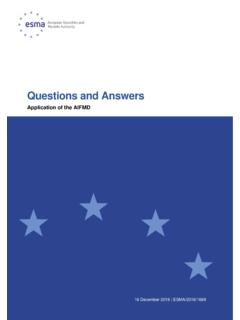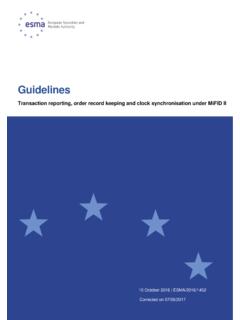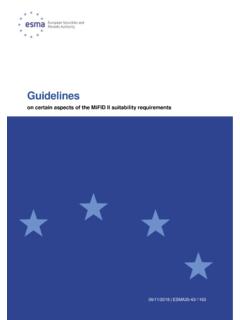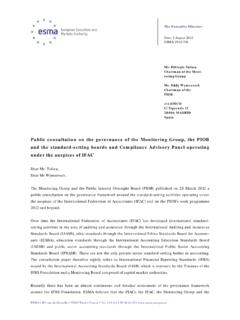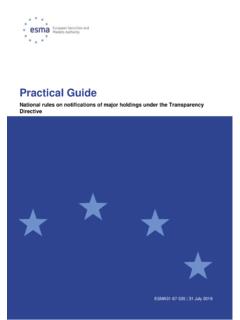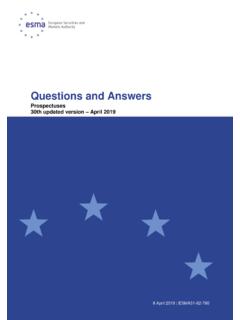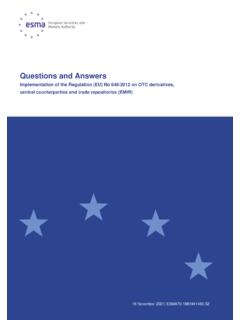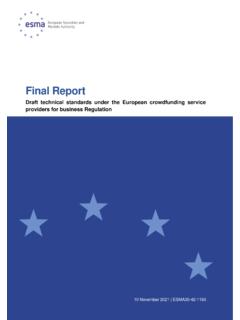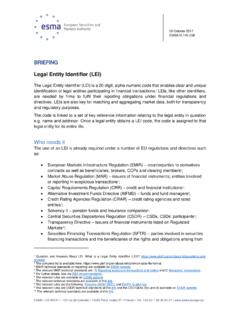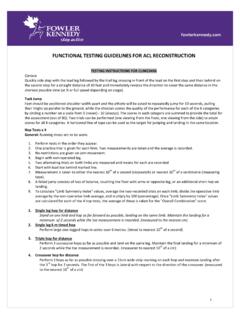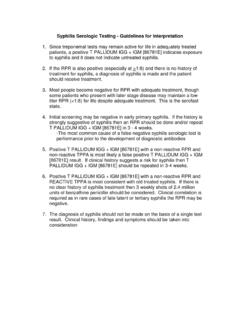Transcription of Guidelines on Liquidity Stress Testing in UCITS and AIFs
1 16/07/2020 | ESMA34-39-897 EN Guidelines On Liquidity Stress Testing in UCITS and AIFs 1 Table of Contents Scope .. 2 Legislative references, abbreviations and definitions .. 3 Purpose .. 6 Compliance and reporting obligations .. 6 Guidelines on Liquidity Stress Testing in UCITS and AIFs ..8 2 I Scope Who? 1. These Guidelines apply to managers, depositaries and NCAs. What? 2. These Guidelines relate to Liquidity Stress Testing in UCITS and AIFs. 3. In particular, in respect of managers they apply primarily in relation to Article 16(1) of the AIFMD, Articles 47 and 48 of the AIFMD Level 2 Regulation, Article 51 of the UCITS Directive, Article 40(3) of the UCITS Level 2 Directive and Article 28 of the MMFR.
2 4. In respect of depositaries, these Guidelines apply primarily in relation to Article 21 of the AIFMD, Articles 92 of the AIFMD Level 2 Regulation, Article 22(3) of the UCITS Directive and Article 3 of the UCITS Level 2 Regulation. 5. These Guidelines apply in respect of UCITS and AIFs, including: a) ETFs, whether they operate as UCITS or AIFs1; b) Leveraged closed ended AIFs. 6. The Guidelines in Sections (The design of LST models), (Understanding Liquidity risk), (Governance principles for LST), (The LST policy), ( Guidelines applicable to depositaries), and paragraphs 79 and 81 of Section (Interaction with National Competent Authorities) apply to MMFs, without prejudice to the MMFR and ESMA Guidelines exclusively applying to MMFs2, which prevail in the event of any conflict.
3 7. These Guidelines should be adapted to the nature, scale and complexity of the fund. Furthermore, the topic of LST naturally overlaps with other aspects of Liquidity management in funds, such as managing liquid and less liquid assets, diversification and implementing measures such as ex post a-LMT. These Guidelines are not intended to provide comprehensive guidance regarding Liquidity management issues outside the scope of LST. When? 8. These Guidelines apply from 30 September 2020. 1 For clarity, the existing Guidelines on UCITS receiving collateral under the ESMA ETF Guidelines of ETFs and other UCITS issues (ESMA 2014/937) apply.
4 Paragraph 45 of the ESMA ETF Guidelines on ETFs and other UCITS issues provides that A UCITS receiving collateral for at least 30% of its assets should have an appropriate Stress Testing policy in place to ensure regular Stress tests are carried out under normal and exceptional Liquidity conditions to enable the UCITS to assess the Liquidity risk attached to the collateral . This measure is specific to the circumstances involved for such UCITS whereas the LST Guidelines are intended to provide guidance on the application of Liquidity Stress Testing for investment funds generally and should be taken into account by all UCITS .
5 2 Such as those ESMA Guidelines establishing common reference parameters of the Stress test scenarios to be included in MMF managers Stress tests (currently referred to as ESMA34-49-115 ) 3 II Legislative references, abbreviations and definitions Legislative references UCITS Directive Directive 2009/65/EC on the coordination of laws, regulations and administrative provisions relating to undertakings for collective investment in transferable securities ( UCITS )3. UCITS Level 2 Directive Commission Directive 2010/43/EU implementing Directive 2009/65/EC of the European Parliament and of the Council as regards organisational requirements, conflicts of interest, conduct of business, risk management and content of the agreement between a depositary and a management AIFMD Directive 2011/61/EU on Alternative Investment Fund managers and amending Directives 2003/41/EC and 2009/65/EC and Regulations (EC) No 1060/2009 and (EU) No 1095/20105.
6 AIFMD Level 2 Regulation Commission Delegated Regulation (EU) No 231/2013 supplementing Directive 2011/61/EU of the European Parliament and of the Council with regard to exemptions, general operating conditions, depositaries, leverage, transparency and supervision. CDR (EU) 2016/438 Commission Delegated Regulation (EU) 2016/438 supplementing Directive 2009/65/EC of the European Parliament and of the Council with regard to obligations of depositaries6. MMFR Regulation (EU) 2017/1131 on money market funds7. ESMA Regulation Regulation (EU) No 1095/2010 of the European Parliament and of the Council of 24 November 2010 establishing a European Supervisory Authority (European Securities and Markets Authority), amending Decision No 716/2009/EC and repealing Commission Decision 2009/77/EC8.
7 3 OJ L 302, , p. 32 96 4 OJ L 176, , p. 42 61 5 OJ L 174, , 6 OJ L 78, , p. 11 30 7 OJ L 169, , p. 46 127 8 OJ L 331, , p. 84. 4 Abbreviations AIF Alternative Investment Fund AIF RMP AIFM s Risk Management Policy AIFM Alternative Investment Fund Manager a-LMT Additional Liquidity Management Tool ETF Exchange Traded Fund ESMA European Securities and Markets Authority ESRB European Systemic Risk Board EU European Union FoF Fund of Funds FSB Financial Stability Board FX Foreign Exchange LST Liquidity Stress Testing MMF Money Market Fund NCA National Competent Authority RCR Redemption Coverage Ratio RST Reverse Stress Testing UCITS Undertaking for Collective Investments in
8 Transferable Securities UCITS RMP UCITS Risk Management Process 5 Definitions closed ended AIF an AIF other than an open ended AIF, which is an AIF meeting the criteria of Article 1 (2) of Commission Delegated Regulation (EU) No 694/20149 depositary depositary of a UCITS or an AIF ex post a-LMT tools/measures applied by managers in exceptional circumstances to control or limit dealing in fund units/shares in the interests of investors, including but not limited to suspension of dealing in units, deferral of dealing and side-pocketing fire sale price liquidation of an asset at a material discount to its fair value fund a UCITS or an AIF liquidation cost the cost paid by the seller of an asset for the execution of a given transaction in a timely manner for Liquidity purposes Liquidity risk the risk that a position in the fund cannot be sold.
9 Liquidated or closed at limited cost to comply at any time with obligations to redeem units/shares Liquidity Stress Testing a risk management tool within the overall Liquidity risk management framework of a manager which simulates a range of conditions, including: normal and stressed ( extreme, unlikely or unfavourable) plausible conditions, to assess their potential impact on the funding (liability), assets, overall Liquidity of a fund and, the necessary follow-up action manager (a) in relation to a UCITS , the UCITS management company or, in the case of a self-managed UCITS , the UCITS investment company; (b) in relation to an AIF, the AIFM or an internally-managed AIF; (c) in relation to an MMF, the manager of an MMF.
10 9 OJ L 183, , p. 18. 6 redemption coverage ratio a measurement of the ability of a fund s assets to meet funding obligations arising from the liabilities side of the balance sheet, such as a redemption shock reverse Stress Testing a fund-level Stress test which starts from the identification of the pre-defined outcome with regards to fund Liquidity ( the point at which the fund would no longer be liquid enough to honour requests to redeem units) and then explores scenarios and circumstances that might cause this to occur special arrangements specific types of ex-post a-LMT measures available to some AIFs and which impact investors redemption rights, such as side pockets or gates time to Liquidity an approach, whereby the manager can estimate the amount of assets which could be liquidated at an acceptable cost, for a given time horizon III Purpose 9.
